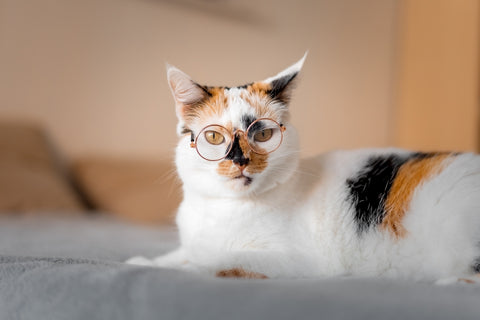
Basepaws recently updated its flagship Breed + Health Cat DNA test to screen for 25 genetic traits that are represented by 50 genetic markers. In a new section of the upgraded Basepaws digital report, pet parents can now learn about the genetic markers that may play a role in determining their cat’s likely blood type.
The Genetics of Feline Blood Types
DNA consists of two chains of nucleotides, and every nucleotide can be one of four bases (adenine, guanine, thymine, or cytosine, also known as A, G, T, and C, respectively). A genetic marker is a specific segment of DNA with a known physical location on a chromosome and a known association with a particular disease or trait. It can help link an inherited trait, such as blood type, with the responsible genes.

There is one blood type system that has been established in domestic cats called the AB system. There are three feline blood types in this system: A, B, and AB*. Out of the seven different genetic markers identified in the scientific literature, only four are known to be relatively reliable and consistent predictors of blood type. It is these four markers that are included in the updated Basepaws Cat DNA test.
These markers occur in the cytidine monophospho-N-acetylneuraminic acid hydroxylase (CMAH) gene, which is associated with feline blood types.
The mutations represented by these four markers are:
- G>T
- T>A
- C>T
- delT
The letter abbreviations are for the nucleotide bases adenine (A), guanine (G), thymine (T), and cytosine (C). A nucleotide replacement is indicated by a greater than (>) symbol and a deletion (del) indicates the loss of genetic material. For example, in our list above G>T means that the nucleotide guanine (G) was replaced by the nucleotide thymine (T), whereas delT indicates that the nucleotide thymine (T) is missing.
(*Note: A fourth blood type, MiK, has also been identified, yet not much is known about it other than the fact that it is also very rare and occurs in less than 1% of cats.)
Blood Type Section of the Basepaws Report
This new section of the Basepaws digital report provides results for your cat’s likely blood type, based on their genotype. Their results will include the number of copies that your cat has (or does not have) for each mutation of the CMAH gene. Based on this breakdown, your cat is designated into one of the three feline blood types as follows**:
Blood type A: A cat is designated as blood type A if it has zero or one copy of mutations G>T, T>A, or del(T) in the CMAH gene. An estimated 70+ percent of cats have blood type A, which is considered the most prevalent feline blood type. Most cats with blood type A are of European or American descent.
Blood type B: A cat is designated as type B if it has two copies of any of the four mutations. The prevalence of blood type B varies widely, depending on a cat's pedigree. Depending on geography, blood type B can occur more frequently in Ragdoll, British Shorthair, and rexoid breeds (e.g., Devon Rex). It is rarely seen in Maine Coons or Norwegian Forest Cats.
Blood type AB: A cat is designated as type AB if it has two copies of the C>T mutation or has one copy of the C>T mutation—but this must occur in combination with one of the other three mutations characteristic of blood type B. This blood type can be more prevalent in Ragdolls and some mixed-breed cats. This blood type is exceedingly rare, with an estimated prevalence across pedigreed and non-pedigreed cats of less than 1%.
(**Note: A deeper understanding of the role of genetics in feline blood type determination is still evolving, so the feline blood type results in a Basepaws report should be interpreted as highly likely rather than 100% definitive.)
Blood Transfusion Risk
The new report section also includes an assessment of a cat’s blood transfusion risk based on the cat’s likely blood type (A, B, or AB) result. Based on this result, a designation of “Low”, “Medium”, or “High” risk will be indicated as follows:
If the cat’s likely blood type is AB: “Low” transfusion risk designation. It is recommended that the blood types of both the donor and the recipient are established before a transfusion. While transfusion from type B donors to type AB recipients should be avoided, AB recipients usually handle transfusions from type A and type AB donors well.
If the cat's likely blood type is A: “Medium” transfusion risk designation. It is recommended that the blood types of both the donor and the recipient are established before a transfusion. Cats with blood type A should only receive blood from cats of the same blood type. Transfusion from type B donors to type A recipients does not work efficiently and may be accompanied by mild incompatibility symptoms such as restlessness, tachycardia, and tachypnea.
If the cat’s likely blood type is B: “High” transfusion risk designation. It is recommended that the blood types of both the donor and the recipient are established before a transfusion. Cats with blood type B should only receive blood from cats of the same blood type. Transfusion from type A donors to type B recipients should be avoided, since the cat may develop a severe hemolytic transfusion reaction, which carries the risk of death.
Breeders also need to know blood type to prevent conditions such as feline neonatal isoerythrolysis (FIN), which appears when a blood type B female (queen) mates with a blood type A male (tom). Cats can naturally possess antibodies against their opposite blood type, and blood type B cats are known to have strong antibodies to type A red blood cells (RBCs). When FIN occurs, the RBCs of a type A kitten are destroyed by the antibodies that its type B mother produces, resulting in postnatal death.
We are thrilled to offer this new feline blood type and transfusion risk section in the Basepaws digital report to equip pet parents with even more information that may help them support their cat’s overall health and wellbeing. However, due to the imperfect relationship between genetics and blood type, Basepaws strongly recommends that you always have your veterinarian perform a serological blood typing test for your cat when blood type information is needed to make medical decisions.
If you have any questions about this post or about the Basepaws Breed + Health Cat DNA test digital report, you can send them via email to meow@basepaws.com.
If you are a veterinarian, please visit the Basepaws “For Vets” page to learn more about Basepaws reports, clinical guides for test interpretation, and how to contact us with questions specific to your needs.
Get a Cat DNA Test


